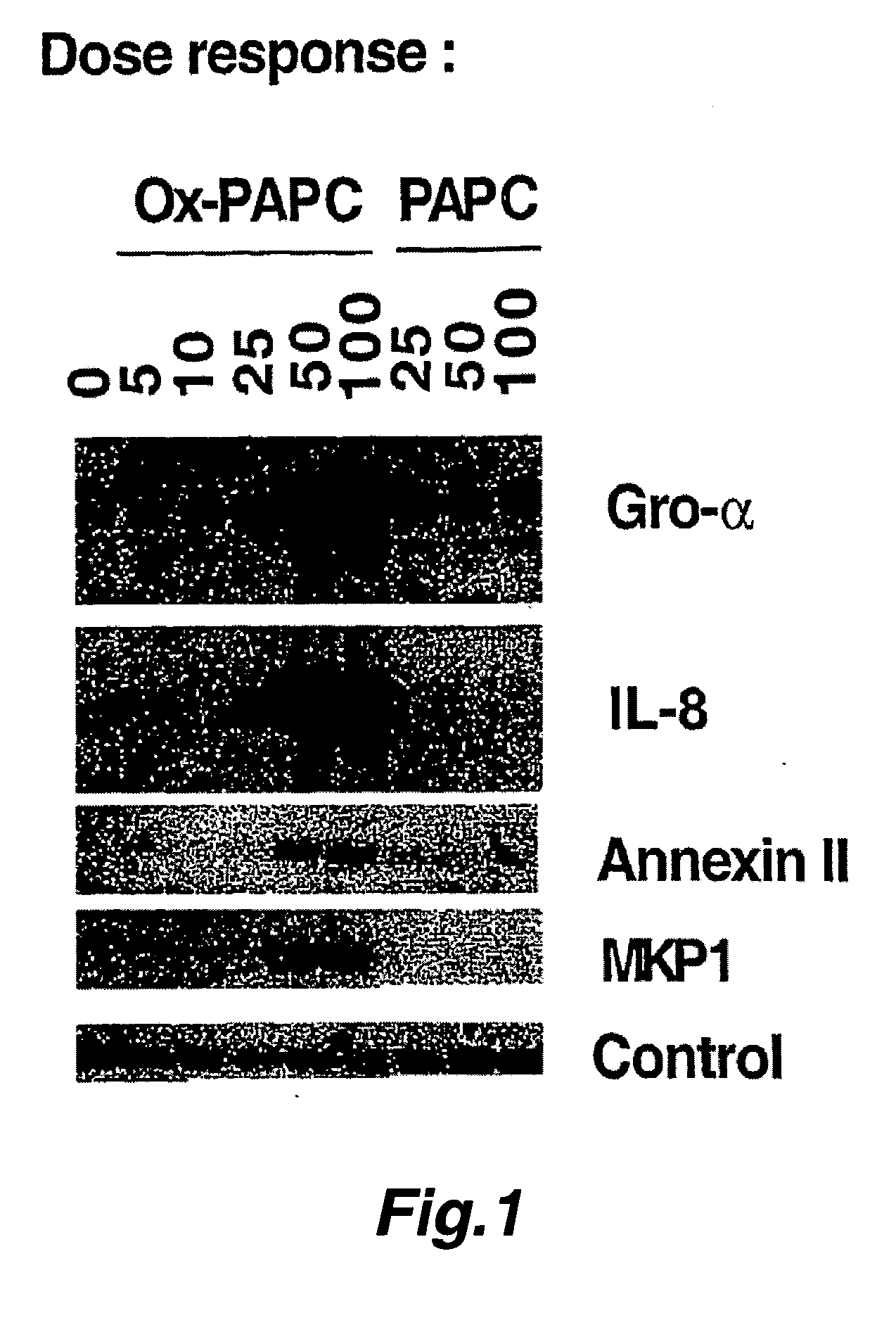Control of gene induced by oxidated lipids in human artery wall cells
a technology of oxidation lipids and vascular wall cells, which is applied in the direction of peptide/protein ingredients, peptide sources, instruments, etc., can solve the problems of poor prognostic indicators at individual level, hdl and/or ldl measurements are leading causes cardiac disease is a leading cause of morbidity and mortality, etc., to facilitate the addition of additional moieties and increase the stability and half-life of such molecules
- Summary
- Abstract
- Description
- Claims
- Application Information
AI Technical Summary
Benefits of technology
Problems solved by technology
Method used
Image
Examples
example 1
MKP-1 is Upregulated in Response to Mildly or Highly Oxidized LDL or Components Thereof
[0296] Confluent cultures of human aortic endothelial cells (HAECs) were treated for 4 hours with various concentrations (as shown in FIG. 1) of Ox-PAPC or PAPC. Following the treatments, cells were lysed and total RNA was isolated. 10 μg of total RNA from each condition was subjected gel electrophoresis and transferred to a nitrocellulose membrane. The immobilized RNA was hybridized to radiolabeled cDNA for human Gro-α, IL-8, Annexin II, MKP-1 and a control gene (GAPDH).
[0297] In another experiment, confluent cultures of HAECs were treated with Ox-PAPC (50 μg / ml) or PAPC (50 μg / ml). At various time points (as indicated in FIG. 2) cells were lysed and total RNA was isolated. 10 μg of total RNA from each condition was subjected gel electrophoresis and transferred to a nitrocellulose membrane. The immobilized RNA was hybridized to radiolabeled cDNA for human IL-8, Annexin II and MKP-1.
[0298] HAEC...
example 2
Ameliorate Atherosclerosis and Other Inflammatory Conditions
[0301]FIG. 6 shows the effect of 1,2-dimyristoyl-sn-glycero-3-phosphocholine (1,2-ditetradecanoyl-sn-glycero-3-phosphocholine) and egg yolk lecithin on lipoprotein cholesterol levels in apo E deficient mice. Apo E deficient mice were purchased from Jackson Laboratories (Bar Harbor, Me.). The mice were 5 weeks old at the time of the experiments. The animals were maintained on a chow diet containing 4% fat, obtained from Ralston-Purina (St. Louis, Mo.). Synthetic 1,2-ditetradecanoyl-sn-glycero-3-phosphocholine (shown in the figure as circles at 24 h and as triangles at 48 h and abbreviated as DGP; 99+% purity, catalog # P 2663, Lot # 17H8362, Sigma Chemical Company, St. Louis Mo.) was added at 2.0 mg / ml to the drinking water of one group of apo E deficient mice (n=5). The second group (n=5) were given 2.0 mg / ml of egg yolk lecithin (Sigma catalog # P 7318) in their drinking water (shown as squares and only the 48 h time poin...
example 3
Ditetradecanoyl Glycero Phosphorylcholine Causes Lesion Regression
[0308] Apo E deficient mice were purchased from Jackson Laboratories (Bar Harbor, Me.). The mice were maintained on a chow diet containing 4% fat, obtained from Ralston-Purina (St. Louis, Mo.) for 10 months at which time one group (n=5) were sacrificed and lesions determined. A second group (n=8) received 1.0 mg / ml of synthetic 1,2-ditetradecanoyl-sn-glycero-3-phosphorylcholine (DGP, approximately 99% pure, catalog # P 7331, Sigma Chemical Company, St. Louis, Mo.) in their drinking water for another five weeks. A control group (n=6) did not receive any supplements in their drinking water. After 5 weeks of treatment, the animals were sacrificed. The hearts and blood vessels from the three groups were harvested and processed as previously reported (Qiao 1994) to determine lesion area. As expected the mice that received drinking water alone showed progression of their lesions during the additional five weeks (see FIG. 1...
PUM
| Property | Measurement | Unit |
|---|---|---|
| Adhesion strength | aaaaa | aaaaa |
Abstract
Description
Claims
Application Information
 Login to View More
Login to View More - R&D
- Intellectual Property
- Life Sciences
- Materials
- Tech Scout
- Unparalleled Data Quality
- Higher Quality Content
- 60% Fewer Hallucinations
Browse by: Latest US Patents, China's latest patents, Technical Efficacy Thesaurus, Application Domain, Technology Topic, Popular Technical Reports.
© 2025 PatSnap. All rights reserved.Legal|Privacy policy|Modern Slavery Act Transparency Statement|Sitemap|About US| Contact US: help@patsnap.com



